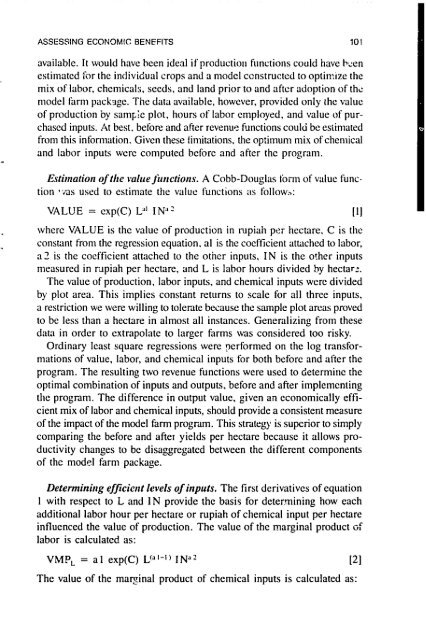Conservation farming on steep lands - USAid
Conservation farming on steep lands - USAid
Conservation farming on steep lands - USAid
You also want an ePaper? Increase the reach of your titles
YUMPU automatically turns print PDFs into web optimized ePapers that Google loves.
ASSESSING ECONOMIC BENEFITS 10 1<br />
-<br />
available. It would have been ideal if productior~ functi<strong>on</strong>s could have bcen<br />
estimated fhr the intlividual crops and a niodel ccnstructed to optim~ze the<br />
mix of labor, cheniicals. seeds, and land prior to and after adopti<strong>on</strong> of thc:<br />
niodel farni packsge. The data available, however, provided <strong>on</strong>ly the value<br />
of prc)ducti<strong>on</strong> by sam@ plot, hours of labor employed, and value of purchased<br />
inputs. At best, before and after revenuc functi<strong>on</strong>s could be estimated<br />
from this informati<strong>on</strong>. Given these limitati<strong>on</strong>s, the optimum mix of chemical<br />
and labor inputs were computed before and after the program.<br />
Estitnati<strong>on</strong> of tlle valrte jitnctiotrs. A Cobb-Douglas foi-m of value hncti<strong>on</strong><br />
-;ras used to estimate the value functi<strong>on</strong>s as follow.,:<br />
VALUE = exp(C) L"' IN:'?<br />
where VALUE is the value of producti<strong>on</strong> in rupiah per hectare. C is the<br />
c<strong>on</strong>stant from the regressi<strong>on</strong> equati<strong>on</strong>. al is the coefticient attached to labor,<br />
a2 is the coefficient attached to the other inputs, IN is the other inputs<br />
measured in rclpiah per hectare, and L is labor hours divided by hectar-.<br />
The value of producti<strong>on</strong>, labor inputs, and chemical inputs were divided<br />
by plot area. This implies c<strong>on</strong>stant returns to scale for all three inputs,<br />
a restricti<strong>on</strong> we were willing to tolerate because the sample plot areas proved<br />
to be less than a hectare in almost all instances. Generalizing from these<br />
data in order to extrapolate to larger farms was c<strong>on</strong>sidered too risky.<br />
Ordinary least square regressi<strong>on</strong>s were 7erformed <strong>on</strong> the log transformati<strong>on</strong>s<br />
of value, labor, and chemical inputs for both before and after the<br />
program. The resulting two revenue functi<strong>on</strong>s were used to determine the<br />
optimal combinati<strong>on</strong> of inputs and outputs, before and after implementing<br />
the program. The difference in output value, given an ec<strong>on</strong>omically efficient<br />
mix of labor and chemical inputs, should provide a c<strong>on</strong>sistent measure<br />
of the impact of the model farm program. This strdlegy is superior to siniply<br />
comparing the before and after yields per hectare because it allows productivity<br />
changes to be disaggregated between the different comp<strong>on</strong>ents<br />
of the model farm package.<br />
[I]<br />
Detenninit~g efficicttt levels of inputs. The first derivatives of equati<strong>on</strong><br />
1 with respect to L and IN provide the basis for determining how each<br />
additi<strong>on</strong>al labor hour per hectare or rupiah of chemical input per hectare<br />
influenced the value of producti<strong>on</strong>. The value of the marginal product of<br />
labor is calculated as:<br />
VMP, = a 1 exp(C) L(" '-I ) IN" ' [21<br />
The value of the maeinal product of chemical inputs is calculated as:
















